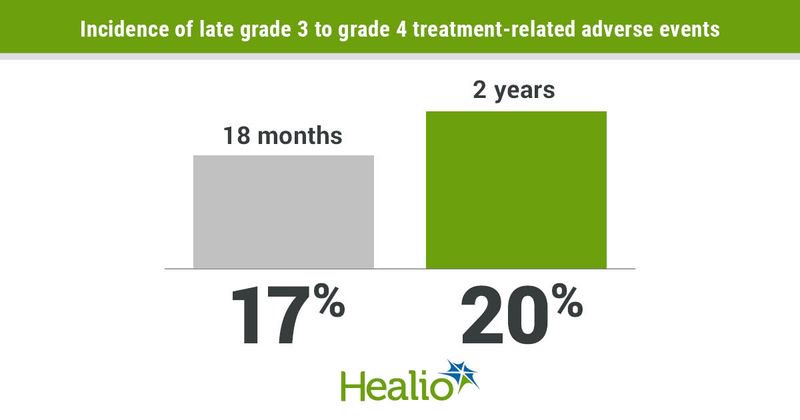Stereotactic body radiotherapy appears safe for treatment of multiple metastases
Treatment with stereotactic body radiotherapy resulted in no protocol-defined dose-limiting toxicities among patients with oligometastatic breast, prostate or non-small cell lung cancers, according to results of the phase 1 NRG-BR001 trial.
However, the incidence of late grade 3 adverse events emphasized the need for continued follow-up among surviving patients, according to the researchers.

“Prior to this trial, little to no evidence was available to support that SBRT is a safe and tolerable treatment option for patients who have multiple metastases,” Steven J. Chmura, MD, PhD, associate professor in the department of radiation and cellular oncology at The University of Chicago Comprehensive Cancer Center, said in a press release. “Researchers have hypothesized that SBRT could improve survival outcomes for this patient population; however, it was imperative we determine the safety of this procedure, appropriate dose and scheduling, and how to coordinate across multiple centers the quality assurance of the procedures prior to testing its efficacy.”
Chmura and colleagues sought to evaluate the incidence of dose-limiting toxicities — defined as specific, SBRT-related grade 3 to grade 5 events measured using Common Terminology Criteria for Adverse Events, version 4.0 — that occurred within 180 days of SBRT administered to patients with three or four metastases, or two metastases in close proximity. SBRT dose varied according to the location of the seven metastatic locations evaluated, which included bone or spine (30 Gy in three fractions); peripheral lung, abdomen/pelvis or liver (45 Gy in three fractions); and central lung or mediastinal/cervical lymph node (50 Gy in five fractions).
The analysis included data of 35 patients (mean age, 63.1 years; 57.1% men; 85.7% white) with breast cancer (34.3%), NSCLC (28.6%) or prostate cancer (37.1%) and a median three metastases (range, 2-4) treated with SBRT who were eligible for assessment of dose-limiting toxicities.
Median follow-up was 22.6 months.
Overall, researchers reported no protocol-specified dose-limiting toxicities in the seven metastatic locations within 180 days.
Fifty grade 3 to grade 4 adverse events occurred among 18 patients, including 18 events possibly related to SBRT. Six of those deemed possibly related to treatment occurred within 180 days; however, they did not meet the criteria for a dose-limiting toxicity.
Central review determined eight of the adverse events to be mechanistically related to SBRT, including two that occurred within 180 days: grade 3 pneumonitis in a patient with breast cancer treated for three metastases (central and peripheral lung and mediastinal/cervical lymph node), and grade 3 gastric ulcer in a patient with NSCLC treated for two metastases in the liver and one in the abdomen/pelvis. The other six adverse events — all of which occurred after 180 days — included bone pain, pulmonary fibrosis, bronchial fistula, bronchial stenosis, spinal fracture and humeral fracture.
Researchers reported total incidences of late grade 3 to grade 4 treatment-related adverse events of 17% (95% CI, 7-32) at 18 months and 20% (95% CI, 9-35) at 2 years.
Median survival had not been reached, with an estimated 2-year OS rate of 57% (95% CI, 38-72).
“These dosing schemes are important, as the use of SBRT to treat multiple metastases is increasing with mounting randomized evidence,” the researchers wrote, adding that the doses evaluated in this trial are also being used in ongoing trials, including the phase 2/phase 3 NRG-BR002 trial of patients with metastatic breast cancer.
In an accompanying editor’s note, Charles R. Thomas Jr., MD, described this study as “a necessary first draft” and “not perfect,” providing evidence for patient care and a framework for future analysis. However, given patients with advanced lung, breast and prostate cancer are living longer due to the efficacy of new systemic agents, long-term toxic effects of this approach should be weighed against the potential benefits, he added.
“Because these toxic effects, particularly bone [fractures] and pulmonary toxicity, can compromise daily quality of life, we strongly believe that clinicians must be sure to caution patients about the specific normal tissue toxicity profile that can occur depending on the anatomic site that is to be targeted with SBRT,” Thomas wrote.
References:
Chmura S, et al. JAMA Oncol. 2021;doi:10.1001/jamaoncol.2021.0687.
Thomas CR. JAMA Oncol. 2021;doi:10.1001/jamaoncol.2021.0677.

